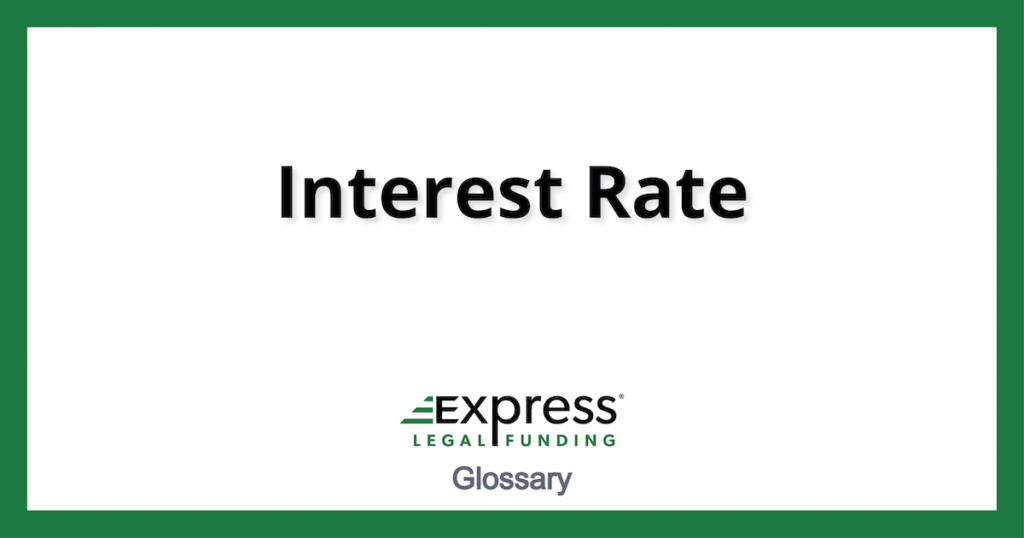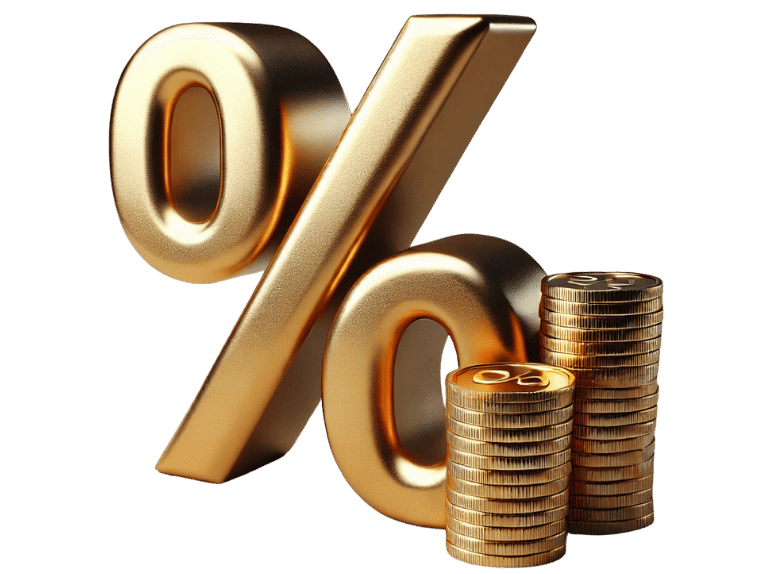An interest rate is the cost of borrowing money, expressed as a percentage of the principal amount over a specified period. It represents the price lenders charge borrowers for using their funds and applies to a wide range of financial products, including loans, mortgages, credit cards, and investment accounts.
Understanding how interest rates work, what influences them, and the different types available can help individuals and businesses make informed financial decisions.
What Is an Interest Rate?
In simple terms, an interest rate is the percentage a lender charges a borrower for using their money over a specific period. It represents the cost of borrowing and is typically expressed annually as the annual percentage rate (APR). Interest rates apply to various financial products, including loans, credit cards, and mortgages.
Interest rates also play a role in savings accounts and investment products, where financial institutions pay account holders a return on their deposits. In this case, the rate determines how much interest earnings a depositor receives over time.
For lenders, the rate of return and return on capital are key considerations when evaluating the profitability of a credit investment.
Several factors influence interest rates, including market conditions, economic indicators, central bank policies, the type of currency lent, and the borrower’s creditworthiness. These elements collectively determine the cost of borrowing and the returns lenders can expect.

How Are Interest Rates Determined?
Interest rates are influenced by a combination of economic conditions, government policies, and individual borrower factors. The primary influences include:
- Federal Reserve Policies: The U.S. Federal Reserve sets the federal funds rate, which affects how much banks charge each other for short-term loans. This, in turn, influences lending rates for consumers and businesses.
- Inflation: Higher inflation typically leads to higher interest rates as lenders need to compensate for the decreasing purchasing power of money. Conversely, lower inflation often results in lower interest rates.
- Market Demand for Credit: If many consumers and businesses are seeking loans, lenders may raise interest rates. If demand is low, rates may be lowered to encourage borrowing.
- Risk and Creditworthiness: Lenders assess the risk of lending money by evaluating a borrower’s credit score, income, debt-to-income ratio, and financial history. Riskier borrowers typically receive higher interest rates.
- Loan Type and Term: Short-term loans often have lower interest rates compared to long-term loans, as lenders take on more risk with longer repayment periods.
What Factors Affect the Interest Rate I Receive?
The specific interest rate a borrower receives depends on various personal and economic factors, including:
- Credit Score: Lenders use credit scores to assess financial responsibility. Higher scores (typically 700 and above) often qualify for lower interest rates, while lower scores may lead to higher rates.
- Debt-to-Income Ratio (DTI): This measures the percentage of a borrower’s income that goes toward debt payments. A lower DTI indicates better financial stability and can result in a lower interest rate.
- Loan Type: Secured loans (backed by collateral like a house or car) usually have lower rates than unsecured loans (such as credit cards or personal loans).
- Loan Term: Shorter loan terms tend to have lower interest rates because lenders take on less risk compared to longer repayment periods.
- Lender Policies: Different banks, credit unions, and financial institutions set their own interest rates based on their risk assessment and market competition.
- Economic Conditions: In times of economic growth, interest rates may rise due to increased borrowing demand, while during recessions, rates often decrease to encourage borrowing.
Is a Lower Interest Rate Always Better?
While a lower interest rate generally means lower borrowing costs, it is not always the best option. Other factors to consider include:
- Loan Fees: Some loans with lower interest rates may come with high upfront fees, closing costs, or annual fees that increase the overall cost.
- Loan Term Length: A lower interest rate on a longer loan term can result in higher total interest paid over time. For example, a 30-year mortgage at 3% might cost more in total interest than a 15-year mortgage at 3.5%.
- Prepayment Penalties: Some loans with lower interest rates may include penalties for early repayment, limiting financial flexibility.
- Variable vs. Fixed Rates: A lower introductory rate on a variable interest loan can increase over time, making it more expensive in the long run compared to a slightly higher but stable fixed rate.
Before choosing a loan, borrowers should calculate the total cost of borrowing by considering both the interest rate and additional fees to ensure they are getting the best deal for their financial situation.
What Are the Types of Interest Rates
Interest rates come in various forms, each with distinct characteristics and applications. Below are the most common types:
Types of Interest Rates
1. Simple Interest
Simple interest is calculated by multiplying the principal balance by the interest rate and the loan duration. Unlike compound interest, it does not account for accumulated interest over time.
- Formula: A=P(1+rt)A = P(1 + rt)A=P(1+rt)
- Example: If you borrow $1,000 at a 5% annual simple interest rate for three years, you will owe $1,150 at the end of the term.
2. Compound Interest
Compound interest is calculated based on both the initial principal and any accumulated interest from previous periods. This results in exponential growth over time, making it beneficial for investments but costly for borrowers.
- Formula: A=P(1+rn)ntA = P(1 + \frac{r}{n})^{nt}A=P(1+nr)nt
- Example: A savings account earning compound interest will generate more interest over time as past earnings also accrue interest.
3. Fixed Interest
A fixed interest rate remains unchanged throughout the loan or investment term, ensuring predictable payments. It is commonly used in mortgages, auto loans, and bonds.
- Example: A 30-year fixed mortgage at 4% interest ensures that the borrower’s monthly payment remains the same over the loan’s duration.
4. Floating (Variable) Interest
Floating interest rates fluctuate based on changes in a benchmark index, such as the prime rate, LIBOR, or SOFR. This type of interest is commonly used in adjustable-rate mortgages (ARMs) and credit lines.
- Example: A credit card with a variable APR of 15% might increase to 18% if the benchmark interest rate rises.
5. Nominal Interest
The nominal interest rate is the stated or advertised rate that does not factor in inflation, compounding frequency, or additional fees.
- Example: A loan advertised with a 7% nominal interest rate may have a higher effective rate if compounding or fees are included.
6. Real Interest
The real interest rate accounts for inflation, providing a clearer picture of the actual cost of borrowing or return on investment.
- Formula: Real Interest Rate = Nominal Interest Rate – Inflation Rate
- Example: If a bond pays 6% interest but inflation is 3%, the real interest rate is 3%.
7. Prepaid Interest
Prepaid interest refers to interest charges that are paid upfront at the time of loan closing. This is common with mortgages, where borrowers pay interest covering the period between closing and the first scheduled payment.
- Example: If a home loan closes on the 20th of the month but the first payment is due on the 1st, prepaid interest is charged for those extra days.
8. Late Payment Interest
Late payment interest is an additional charge applied when a borrower misses a scheduled payment. This penalty is often a flat percentage added to the overdue amount.
- Example: A 3% late fee applied to a $1,000 overdue payment results in an additional $30 charge.
9. Simple Annualized Interest
This type of interest is calculated using a 365-day calendar, typically applied per diem and does not compound. It differs from APR, which is designed for cost comparisons rather than precise interest calculations.
- Example: A loan with a 10% simple annualized interest rate accrues daily interest but does not include compounding effects.
10. Effective Annual Interest (APY/AER)
The effective annual interest rate (also known as APY or AER) includes compounding effects and additional fees, providing a more accurate reflection of the total cost of borrowing or the return on an investment.
- Example: A credit card with a 19.99% nominal interest rate and daily compounding may have an effective annual rate exceeding 22%.
Each type of interest serves a unique purpose, and understanding these differences helps borrowers and investors make more informed financial decisions.
What Is the Difference Between Fixed and Variable Interest Rates?
- Fixed Interest Rate: This type of interest rate remains constant for the entire duration of the loan or financial product. It provides stability because the borrower’s payments remain predictable over time.
- Example: A 30-year fixed mortgage at 4% means the interest rate will not change, regardless of market fluctuations.
- Variable Interest Rate: This type of interest rate fluctuates based on a benchmark index, such as the prime rate or LIBOR. It can result in lower payments when market rates drop but may lead to higher costs if rates increase.
- Example: A credit card with a 12% variable APR may increase to 15% if the prime rate rises, making it more expensive over time.
Choosing between fixed and variable interest rates depends on factors like financial stability, risk tolerance, and market conditions.
How Do Changes in Market Conditions Impact Interest Rates?
Market conditions significantly influence interest rates, as lenders and financial institutions adjust borrowing costs based on economic trends. Several key factors determine how interest rates fluctuate:
1. Supply and Demand for Credit:
Interest rates are directly impacted by the balance between credit supply and borrower demand:
- High Demand, Limited Supply: When many borrowers seek loans but lenders have limited funds available, interest rates tend to rise. Lenders increase rates to maximize returns and manage risk.
- Low Demand, High Supply: If fewer people or businesses seek credit, lenders may lower interest rates to attract more borrowers.
2. Inflation:
Inflation plays a crucial role in determining interest rates:
- High Inflation: Lenders raise interest rates to compensate for the decreasing purchasing power of money over time. Borrowers must pay more to offset inflationary risks.
- Low Inflation: Lower inflation levels allow lenders to reduce interest rates, encouraging borrowing and economic expansion.
3. Central Bank Policies:
Central banks, such as the Federal Reserve (Fed) in the U.S., actively influence interest rates through monetary policy:
- Lowering Interest Rates: If the central bank wants to stimulate the economy, it reduces benchmark rates, making borrowing cheaper and encouraging spending.
- Raising Interest Rates: If the economy is overheating and inflation rises too quickly, the central bank increases rates to slow borrowing and stabilize prices.
4. Economic Indicators:
Various economic indicators impact interest rates by reflecting overall market conditions:
- Strong Economic Growth (High GDP, Low Unemployment, High Consumer Confidence): Lenders may increase interest rates due to higher demand for credit and strong investment activity.
- Economic Slowdown or Recession (Declining GDP, Rising Unemployment, Low Consumer Confidence): Interest rates often decrease to encourage borrowing, investment, and spending, helping stimulate economic recovery.
Interest rates are highly responsive to shifts in market conditions, inflation levels, central bank policies, and broader economic trends. Understanding these factors can help businesses and individuals make more informed borrowing and investment decisions.

